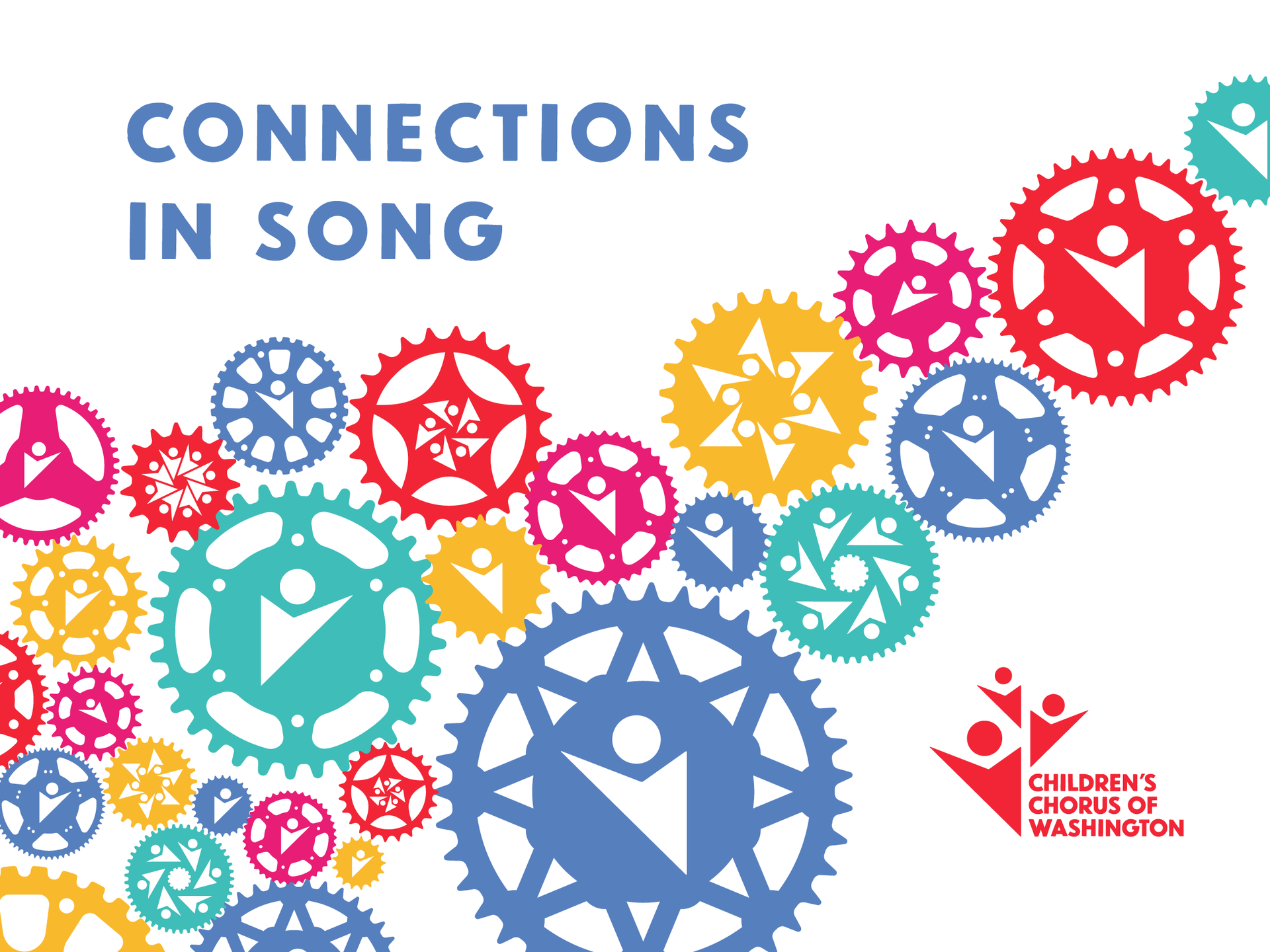
Jambo - Teddy Kalanda Harrison, arr. Jacob Narverud
Jambo bwana, habari gani? Mzuri sana Wageni mwakaribishwa Kenya yetu Hakuna matata
Kenya nchi nzuri, Sote nchi ya maajabu Nichi yenye amani,
Kenya yetur Kenya wote
Hello mister. How are you? Very fine.
Visitors are welcome in our country (Kenya) There are no worries.
Kenya is a beautiful country all a land of wonders and a peaceful country
Our Kenya, All Kenya
We want to begin our concert with a welcome song and this Kenyan melody immediately invites our singers and listeners to join together in a spirit of connection. In many African cultures, the call and response format is a fundamental part of their community which creates a musical dialogue between our singers.
I will never forget when we toured South Africa, singing was the connection that immediately built a common language and bond between our singers and the people in the South African townships. Singing creates that instant connection we feel with one another.
Margaret Nomura Clark
Rainbow Connection - Paul Williams and Kenneth Ascher
Why are there so many songs about rainbows and what’s on the other side? Rainbows are visions but only illusions, and rainbows have nothing to hide.
This classic song, “The Rainbow Connection,” was written for the opening of “The Muppet Movie,” released in 1979. Sung by Kermit the Frog (Jim Henson) this song was nominated for an Academy Award that year. Certainly, rainbows are meant to be wished on. They are elusive visions, and represent something larger than ourselves. Rainbows are a bridge that connect to our dreams and guide us through the storms in our lives. They are symbols of hope and joy. In 2020 “The Rainbow Connection” was added to the National Recording Registry of the Library of Congress.
Friendship Canon - Mark Burrows
Kindness and generosity are powerful ways to feel connected to one another, even if we don’t speak the same language. In this piece, the winding melody is sung first in unison, then in a two- and three-part canon, representing our interconnectedness and reliance on one another. Languages presented in this song include: Irish, Spanish, Greek, Swahili, Russian, Japanese, Cherokee, Hebrew, Hindi, German, Korean, Arabic, Yoruba, Maori, Chichewa, and Danish. In how many languages can you say “friend”?
Circle Round the Moon - Mark Hierholzer
Inspired by child recollections, the imaginative language of this piece suggests that nature itself “invites me to come out” to playfully explore the outdoors. No matter if we are high above the trees, or exploring deep caverns, we are not alone. We are joined by “you”, perhaps a family member or a friend, who reminds us of the joy and sheer delight that is all around, if we choose to see it. As the song ends it is revealed that this special person may not be with us any longer, yet we will forever be connected to them through our memories of our adventures together.
La Sopa De Isabel - Francisco Nunez
Presented from 3-year-old Sebastián’s perspective, the Dominican merengue music paints a picture of him excitedly waddling across the kitchen floor. Close behind is his abuela, who is trying to get the rambunctious toddler to try a spoonful of soup in a sing-songy voice while his mother finishes preparing the meal. This piece was inspired by real-life events in Francisco Nunez’s home, as his wife (Elisabeth, or “Isabel”) cooked a soup from her Irish heritage combined with Dominican flavors. As you listen to this song, we invite you to reflect on your own memories of cooking together with loved ones, sharing recipes across cultures and generations, and the challenge of getting a little one to try new food!
En la cocina mi mami se pasa el día
Cortando tocino poniéndole sal
Lavando y majando las papas en agua
Meneate bailando de aqui pa’ allá
Que buena la sopa,
La sopa de papa
Una sopa tan sabrosa
Que nadie la deja
Una sopa tan sabrosa
Bailamos con ella
La sopa de Isabel!
Llorando y cortando cebollas y ajo
un poco de adobo le da el sabor
Damela! Caliente!
Soplala! Sabrosa
In the kitchen my mom spend the day
Cutting bacon and adding salt
Washing and mashing the potatoes in water
I dance and wiggle from here to there
That good soup,
The potato soup
A soup so tasty
No one would leave it
A soup so tasty
We danced with her
Elizabeth’s soup!
Crying while chopping onions and garlic
A little adobo to give it the flavor
Give me some! Hot
I’ll blow on it! Delicious!
Birdsong - Paul Read
Birdsong is based upon a poem found amidst a collection of poems that were written by children in the Terezin concentration camp during WWII in Czechoslovakia (now Czech republic). The poems reflected the experiences, hopes and dreams of the children. Birdsong describes the beauty of the world with a sense of gratitude - rather than dwelling on the horrors that befell the young author. The text is positive, describing the beauty of nature and joy of living each day. When juxtaposed to the daily life of the concentration camp, one realizes that gratitude is a choice - regardless of circumstance.
We Will - Jim Papoulis
This piece, We Will, was composed in a workshop with the Miami Children’s Chorus within 30 days of the 9/11 crisis. The students shared their candid feelings about the events.
“We Will is a result of real thoughts, feelings, and hopes. The words that the children helped to write, speak for themselves; those words are their gift to the world, to other children who struggle with trying to make sense of this world.”
In swahili - Si mama, “wototo” means “stand tall, children.” “Chikuah” is purposely nonsensical speak the unexplainable.
Stardust - B.E Boykin
Choir director Marcus J. Jauregui notes, “In Stardust, the singers call for 'a home where we can run' in memory of Ahmaud Arbery, 'a home where we can pray' in memory of the victims of the Mother Emanuel shooting, 'a home where we can breathe’ in memory of George Floyd, and a home 'to sleep and dream without fear' in memory of Breonna Taylor."
The poem, Stardust, by Brittny Ray Crowell is written as a prayer - in honor of those whose lives were taken too soon.
JAM! (Jom-Ayuh-Mari!) - Tracy Wong
This fun upbeat Malaysian inspired song is a three-way play on words! JAM is an acronym for: Jom, Ayuh, Mari - meaning in colloquial Malay “Come, let’s go!” The catchy, repetitive and conversation-like musical themes suggest a group of musicians coming together to make music (akin to a jam session). Jam in Malay also translates to “clock” suggesting a passing of time, represented by the consistent snapping of fingers in the music. The music is saying “Come, let’s go make some music together and sing while passing time! Leave your worries for a while.”
Shenandoah - American Folksong, arr. Kevin Riehle
This beloved American folk song and this particular arrangement reflect the American landscape and beauty of the Shenandoah river. The lyrics tell the story of a canoeing voyageur, or fur trader, who was in love with the daughter of a Native American chief. One can also regard this song as the connection we feel when we marvel in the the natural wonders of country.
Yo Le Canto Todo el Dia - David Brunner
Ya me voy de corazón, Ya me voy con un tambor
Yo le canto todo el dia, Con cariño y alegria, Con cariño y emoción
So I am moving with my heart, So I am leaving with a drum,
I sing to you all day long with affection and joy,
So I am leaving with a drum with affection and emotion.
We become united in song and this piece expresses the playful joyfulness we feel when singing to each other. Inspired and influenced by the music of Venezuela, Brunner captures the vitality, and charm of the region in this original composition.
Consider Yourself - Lionel Bart, arr. John Leavitt
This well known song from the musical “Oliver” seemed the perfect choice for our young boys ensemble to sing as they are building new friendships among their peers.
An Die Musik - Franz Schubert
You, beloved Art, in so many grey hours,
When life’s mad tumult wraps around me,
Have kindled warm love in my heart
And transported me into a better world,
Transported me into a better world!
How often a flowing sigh from your harp,
A sweet, divine harmony from you
Unlocked the heaven of better times to me.
You, beloved Art, I thank you for it!
You, beloved Art, I thank you for it!
Franz Schubert wrote “An Die Musik,” one of his most famous Lieder, setting to music the poetry of his closest friend, Franz von Schober. As much as anything he wrote, Schubert’s Lieder show why Harold Schonberg, American music critic and author, said, “He was the first lyric poet of music.” Craig Courtney’s transcription remains faithful to Schubert’s lyricism. The lied is about the importance of art in the poet’s life and what it has done to enhance his existence. “An Die Music” is a tribute to what “may be the most beautiful thank-you note anyone has ever written, but it’s also something else. It’s a credo, a statement of faith in the wondrous powers of music, and by its very nature an affirmation of those powers.” (Miles Hoffman)
Hard Times - Nick Johnson
The song begins as a simple expression of empathy for those who are less fortunate: the timeless struggle against poverty and inequity. As the piece unfolds, the voices grow more empowered and show resilience, perseverance, and determination. Ultimately, no matter what challenges we may face, the song offers us a universal message that together we can get through the difficult times that inevitably visit our lives.
Swing Down Chariot - Spiritual, arr. The Vagabonds
This gospel/barbershop arrangement by the Vagabonds includes the well-known African American spiritual “Swing Low, Sweet Chariot.” The song is attributed to Wallace Willis, an enslaved African American from Oklahoma. The slow and expressive beginning is followed by a more upbeat section where Ezekial has a vision of an angel working on a chariot. Curious about the chariot, “He just want to see how the chariot feel,” and “lay down his heavy load.” Whether the author is ultimately seeking heaven or freedom, we all can relate to wanting to lay down our sometimes “heavy loads.”
How Can I Keep From Singing - Sarah Quartel
This is Sarah Quartel’s arrangement of a 19th century hymn written by American Baptist minister Robert Lowry. Quartel gives us this thrilling a cappella arrangement which pairs the soaring legato melody with a rhythmic vocal accompaniment. Together, these elements capture both the gentle hope and the profound joy contained in the text while also including moments of tenderness and reflection. The song reminds us of how music and singing can help lead us through the journey of life.
TāReKiṬa - Reena Esmail
TāReKiṬa is a vibrant joyful piece in a rāga (an Indian classical melodic framework) called Jog, which incorporates both major and minor modalities into a single scale. The text syllables are onomatopoeic vocalizations of the sounds produced by Indian instruments. In deciding how to express and communicate through this music, I worked together with Indian Dancer, Shuchi Buch, founder of the Taal Academy of Dance in DC to create a dance using the bharatanatyam form of indian dance, known for its grace and sculpture-like poses to create a story that is related to nature. This piece incorporates mudras or hand gestures that depict elements of nature; a budding flower, trees, deer, the river, and finishing with a gesture of growth and hope for the future.
Ordé e - Maria Vizconde Roldan
Mantaco, mantaco ganganasan
Ay, ila ela elalay
Ay insi insinali dummaay orde-e
Payande, payande unameliyan
Agaggaw, agaggaw way mandonnoy
Come, come let us enjoy singing.
As one community, it is good that you came to us. Everyday, everyday we work
“Orde-e” is a Madukayan folk song from the northern part of the Philippines. This arrangement portrays the soundscape of the Cordilleras, a mountainous region in the archipelago. The piece starts with a peaceful chant, like the rice fields at sunrise. But the tranquility is soon interrupted by animal calls and festival yells of children playing. Serenity finally returns at sunset.
This piece has a direct connection to our singers as they first learned this song last year when we sang together with the Young Voices of the Philippines at Carnegie Hall. We can’t help but remember the special memories we shared with this chorus when we sing this song.
O Love - Elaine Hagenberg
O Love, O love, O Love, that will not let me go,
O Love, I rest my weary soul in Thee;
I give thee back the life I owe, That in thy ocean depths its flow may richer fuller be.
O Joy, O Joy, O Joy, that seeks me through the pain, O Joy, I can not close my heart to thee;
I trace the rainbow through the rain, and feel the promise is not vain that morn shall tearless be.
O Love, O Love, O Love, that will not let me go.
This beautiful piece immediately captured my attention and is a song of lost love and a reminder of how we keep our loved ones close at heart and never forget them.
Sigue - Ivette Herryman Rodriguez
Camina, caminante, Sigue; Camina y no te pare, Sigue.
Cuando pase po su casa, No le diga Que me bite,
Camina, caminante, Sigue
No le mire site llama, Sigue.
Acuérdate que ella es mala, Sigue
Walk traveler, Continue walking; Walk and do not stop, Continue walking.
When you pass by her house Do not tell her that you saw me, Walk traveler, continue walking.
Do not look if she calls out for you, Continue walking.
Remember that she is bad, continue walking.
The text of Sigue derives from the poem written by the Cuban poet Nicolás Guillėn (1902-1989). In the poem the poet asks a traveler not to mention him walking by the house of a certain woman, who is “bad.” The poet requests the traveler to continue walking and that he not stop, even if she calls him. For our students, the “bad woman” is symbolic of temptations we may be drawn to, whether it be tik tok, video games, junk food, etc. The music has a wonderful bass line and a walking pattern that is characteristic of the Cuban rhythms of the Cuan genre: Son. The triplet pattern that interrupts this pattern represents the”bad” temptation.
Crowded Table - The Highwomen, arr. Andrea Ramsey
The country pop artists, The Highwomen express the message for us to “band together, abandon as much ego as humanly possible and help each other to be open to giving everyone a chance to fit in.
This song has been a part of our seniors’ repertoire since the pandemic and was one that helped them get through the challenging times when we were only able to sing online, stressing the importance of family and friends and embracing the time we can have together.
Al Shlo Sha - Allan Naplan
Al Shlo Sha D’varim haolam kayam, al haemet v’al hadin v’al hashalom
The world is sustained by three things, truth, justice and peace!
Our concert wouldn’t be complete without our CCW anthem that has been a part of our organization since its inception. As is our tradition, we invite any former students or alums to join us on stage while we sing this song. It is the song that connects all of our singers, young and old to CCW and recaptures the many years our choristers are a part of this chorus.
We Are One - Brian Tate
The text in this song seemed the perfect way to close our concert and reflects the mission of CCW and the acts of kindness and care that are witnessed across all of our ensembles, among our staff and families.
Lovely Day - Bill Withers, arr. Robert Gibson
Our final song is Bill Wither’s 1977 Grammy Award winner, Lovely Day. This classic piece was written to bring a smile to your face and a reminder that finding happiness amidst hardship and challenges can be as easy as concentrating on the people and experiences that make us happy. Withers sings, "Then I look at you, and I know it's going to be a lovely day." Cultivating gratitude and appreciation for the people and experiences that enhance our lives is the connection we need to cultivate a meaningful life. We welcome our audience to join us in the song and celebrate this moment of music making together!

